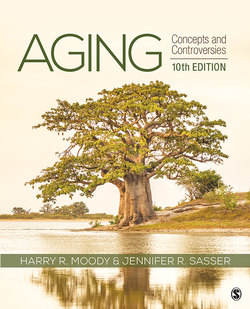Читать книгу Aging - Harry R. Moody - Страница 27
На сайте Литреса книга снята с продажи.
Time and the Life Course
ОглавлениеExpectations about time remain a major element in how we think about aging and the life course today (Hendricks & Peters, 1986). Just as industrialization imposed time schedules on workers to improve efficiency in the workplace, so the life course became scheduled by differentiated life stages and the expectations associated with those stages. The factory and the assembly line had their parallel in the linear life plan. But that mode of organization has become outdated. In a postindustrial information economy, the pace of life is speeding up, and flexible modes of production require a more flexible life course. The volatile global economy demands multiple job changes and thereby makes every career unpredictable. Individuals at any age may be called on again and again to rewrite their biographies, although reinventing oneself gets more difficult as the résumé gets longer.
Another example of our contemporary time orientation is the prolonged period of life devoted to education. The knowledge explosion and pressure for specialization put a premium on added years of schooling, and the job market has fewer places for those without advanced skills. Our postindustrial economy is increasingly based on “knowledge industries,” where emerging fields, such as computer software and biotechnology, favor cognitive flexibility.
The trend toward cognitive flexibility also poses a distinct challenge for an aging society. Middle-aged and older workers, who are perceived to be less creative than younger workers, may be at a disadvantage in the fast-moving labor market. For instance, in some branches of media or advertising, employees are viewed as “old” if they are over the age of 40. But if retirement, the defining institutional feature of old age, is to remain economically feasible, then we will have to develop ways to keep people working as long as they can remain productive. Retraining for displaced workers of whatever age is likely to become an imperative in the future. These trends underscore the importance of adaptability and lifelong learning.
Parenthood offers still another example of our changing time orientation. Demographers estimate that, in the 1930s, 90% of a woman’s years after marriage were spent raising dependent children (Gee, 1987). By the 1950s, that proportion had dropped to 40%, giving rise to what some observers have dubbed the “empty nest syndrome”—an extended postparental period of life that occurs after children have grown up and left home (Lowenthal & Chiriboga, 1972). Because of women’s roles and responsibilities in the family, their later lives typically have greater variability than do men’s (Rindfuss, Swicegood, & Rosenfeld, 1987). Gender roles are increasingly shaped by the power of culture (Gullette, 2004; Pipher, 2019; Walker, 1999).
Another change has been the postponement of childbearing. People often spend more of their lives in their roles as adult children of aging parents than as parents themselves (Brubaker, 1990). But what does it mean, in psychological and social terms, when a “child” is 50 or 60 years old or even older? Even to ask these questions shows that the human life course has changed in ways that are still not fully recognized.
